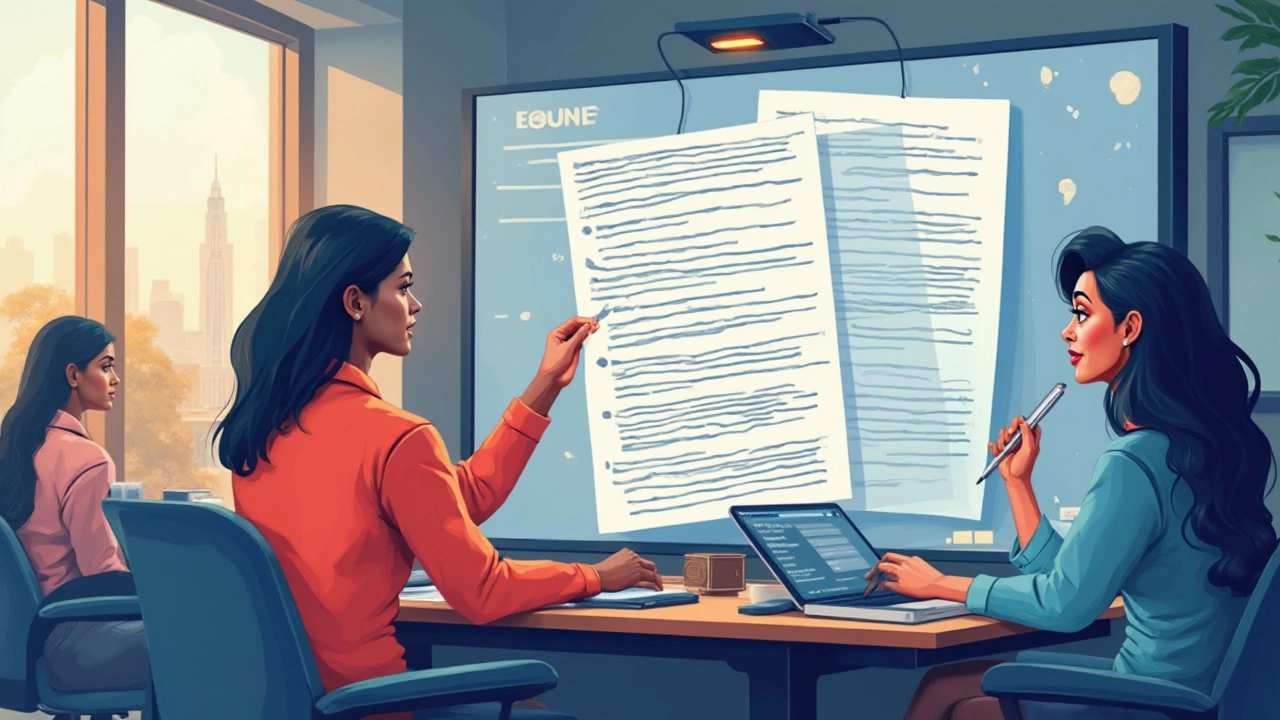Trying to get a job with the US government? You're not alone. Over two million people work for federal agencies, but the hiring process can feel like a maze. The good news—most of the steps are public, the rules are clear, and anyone can apply, no insider connections needed.
The government doesn’t care where you went to college or if you have fancy references. What matters is that you match the job description to a T. That means your resume needs to spell out your experience in plain, direct language—and you’ve got to use the keywords from the job posting. Computers scan your application first before a human ever takes a look, so missing the right words can get you cut right away.
Everything starts at USAJOBS.gov—the main job board for all federal positions. Forget clicking random listings on generic job sites; USAJOBS is where the real openings are. Here, you’ll find jobs ranging from IT to law enforcement, civilian roles in almost every field, and posted requirements for each job in straightforward, no-BS language.
Here’s the truth nobody tells you: applications can be long, sometimes taking hours to finish. But if you pay attention to each part, follow the instructions closely, and don’t rush, you actually put yourself ahead—most people drop out or get rejected for skipping steps. Every requirement listed is non-negotiable. Miss one, and it’s game over. Want to get your foot in the door? Treat every form and question like it actually matters—because for the federal government, it does.
- Understanding Federal Hiring Basics
- Finding the Right Job Openings
- Cracking the Application Process
- Nailing Assessments and Interviews
Understanding Federal Hiring Basics
The federal hiring process isn’t like regular job hunting. There are clear steps and rules that apply to every applicant. If you want to land a US government job, you need to know how the process works from the inside out. Here’s what sets it apart:
- Open to Everyone: Federal jobs have to be posted publicly. You don’t need to know someone on the inside or have a special referral. Every open position is listed on USAJOBS, the official platform.
- Strict Requirements: Each job lists qualifications you must have—like education, past experience, or certain certifications. If you don’t check every box, your application won’t make it past the first round.
- Merit-Based Selection: The government is big on fairness. Once your application hits the system, it goes through a points or score-based review. People aren’t hired just because they’re liked. You’re only considered if you’re shown to be highly qualified, according to the automated system and human review.
Here’s a quick look at how the steps stack up for federal hiring:
| Step | What Happens |
|---|---|
| 1. Find a Job | Search and filter jobs on USAJOBS.gov that fit your background. |
| 2. Submit Application | Fill out detailed questionnaires and upload a specialized resume. |
| 3. Application Review | Automated systems (and actual people) check your info for all requirements. |
| 4. Assessment | You might take additional online tests or answer more questions. |
| 5. Interview & Reference Check | If you score high, you might get invited for an interview or further review. |
| 6. Selection & Offer | Only after all checks are done will someone get the job offer. |
One often-missed detail: Each federal agency hires separately. So, a resume system for a Homeland Security role isn’t the same as for the Department of Agriculture. You might get good at one process and have to re-learn it for the next.
The hiring timeline can drag—sometimes a few weeks, sometimes months—because background checks and security clearances are tough. Don’t get discouraged if you don’t hear back right away. Persistence is key. People who snag federal jobs usually apply to multiple positions at once.
The rules keep things fair, but they also mean no step is optional. As soon as you get lazy with one part, you drop out of the running. Remember, the federal hiring process is designed for precision, not speed.
Finding the Right Job Openings
When you’re looking to break into US government jobs, your best tool is USAJOBS.gov. This isn’t one of those job boards with random postings—this is the main site where the federal government lists almost every open position. You’ll find over 10,000 jobs posted at any given time, from entry-level to experienced roles, in every state and even overseas.
Set up a profile on USAJOBS and use the search filters; they're more powerful than most realize. You can filter by agency, salary, location, or even the type of appointment. For example, if you’re a student or recent grad, look for ‘Pathways’ positions—these are set up just for people new to the federal world.
Don’t skip the small print. Every listing spells out who can apply: some are open to the public, others only for veterans, current federal employees, or specific backgrounds. Click the “Who May Apply” link—if you aren’t in the target group, your application won’t even get a look.
- Set job alerts—so new openings land in your inbox. This saves you time and helps you apply early, which can matter if a job closes after hitting a certain number of applications.
- Dig into agencies most likely to hire. According to the Office of Personnel Management, agencies like the Department of Veterans Affairs and Department of Defense have the most openings every year.
- Use keywords smartly. Search for different job titles or skills—you might find hidden openings with names you didn’t expect. For example, an “Analyst” job might be listed as “Program Specialist.”
Here’s a quick view of high-hiring agencies from last year:
| Agency | Openings Posted |
|---|---|
| Department of Veterans Affairs | 45,000+ |
| Department of Defense | 33,000+ |
| Department of Homeland Security | 20,000+ |
The point? The biggest agencies aren’t always the only game in town, but they do post the most options. Keep your profile up to date, build out your USAJOBS dashboard, and always keep an eye on those deadlines. Once a posting closes, that's it—no late applications accepted.

Cracking the Application Process
Getting through the federal job application isn't like sending out a regular resume. With US government jobs, there are extra steps, and you need to show you’re paying attention. Here’s what really matters if you want to make it past the first round.
First, you have to apply through USAJOBS. Open a free account, complete your online profile, and upload your documents. Every job asks for a tailored resume. Don’t dust off your standard resume—it won’t work. Federal resumes aren’t just longer; the hiring team wants specifics. List every job, duty, and achievement in clear detail. If the description says “three years of budget experience,” spell out exactly when, where, and how you gained that experience. Forget vague phrases. Be direct and match your words to the posting.
Here are the key pieces you need for most applications:
- Federal-Style Resume: 4-6 pages is normal. Include your full work history, detailed duties, hours worked per week, supervisor names, and contact info (unless you ask not to contact them).
- Questionnaire: After you hit “Apply,” you’ll answer a set of questions about your experience and skills. Treat every question as critical; this is used to grade applicants long before anyone sees your resume.
- Supporting Documents: These can include transcripts, veterans’ preference documents, or proof of status (like if you’re a current government employee). Missing just one thing—even a signature—can tank your application.
If you’re claiming veterans’ preference, believe it or not, almost 45% of federal hires use some kind of preference or special status, according to recent Office of Personnel Management data. If you don't upload your DD-214 correctly, you don’t get the points—even if you’re fully qualified.
| Application Step | Common Mistake | Quick Fix |
|---|---|---|
| Resume | Too short, lacks details | Follow federal format, add duties per job |
| Questionnaire | Incomplete answers | Answer every question honestly, don’t skip |
| Documents | Missing one or more required files | Double-check every attachment before submitting |
Don’t forget, applications are usually scored automatically first. If your answers and resume don’t prove you meet every “required qualification,” the system tosses you before a human ever sees your name. Use the exact words from the posting, especially for federal hiring. It’s not cheating—it’s how the screening works.
The process can feel tedious, but those who stick it out and go step-by-step are the ones who get callbacks. If you want that government job, focus on the details, follow instructions, and don’t rush. That’s how you stand out from the crowd.
Nailing Assessments and Interviews
Alright, you’ve made it past the first hurdles—now comes the part that trips up a ton of strong candidates: the assessments and interviews. Here’s where the US government jobs process really starts to separate the folks who are ready from those who just look good on paper.
Most federal jobs will ask you to take one or more assessments right after your application. These can include questionnaires, writing samples, or online tests that check specific skills. For example, a federal IT job might toss you a timed tech quiz, while a policy analyst opening could ask for essays and logic questions. A tip most don’t realize: these tests are scored automatically. That means answers should be consistent with what’s on your resume and application—any mismatch and the computer flags you fast.
When it comes to federal interviews, don’t expect trick questions or riddles. Hiring panels usually stick to structured interviews. You’ll get a list of questions ahead of time, or at the very least, a clear outline of what will be covered. They want to see—not just hear—that you fit the requirements listed in the posting.
One fact that can really help: According to the Office of Personnel Management (OPM), "federal interviews often use the 'STAR' method—Situation, Task, Action, Result—to evaluate if past experience matches the job’s needs."
“Your interview responses are your chance to connect your skills directly to the position. Use specific examples, not generalities." — Office of Personnel Management
Here’s how to prep for these interviews:
- Re-read the vacancy announcement. Every needed skill or responsibility is a potential interview question.
- List real examples from past jobs that fit the STAR format. Keep one story per skill—don’t ramble.
- Practice answering out loud. You want to sound natural, not rehearsed or robotic.
- If invited to an in-person or video call, dress like it’s a regular business job. Most government offices still expect business casual—even on Zoom.
Many federal hiring managers rank candidates using a points system after interviews. A great story or direct answer could make a huge difference. Check out how candidates were rated in a recent Department of the Interior job round:
| Category | Max Points | Avg. Score |
|---|---|---|
| Technical Skills | 30 | 24 |
| Communication | 20 | 15 |
| Problem Solving | 25 | 18 |
| Teamwork | 25 | 20 |
Notice those big point buckets: if you waffle through an answer or skip a skill, there’s no way a good resume can save your score. The big takeaway? Make every answer count, keep your examples tight, and never assume the panel knows how your past experience fits the job—you have to spell it out.

Write a comment